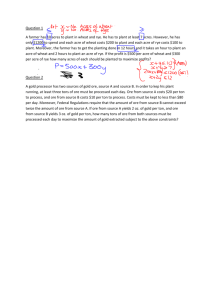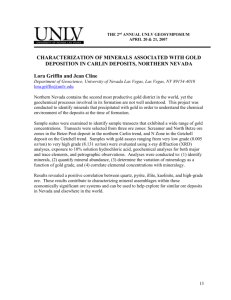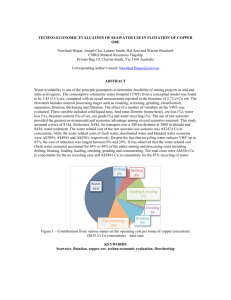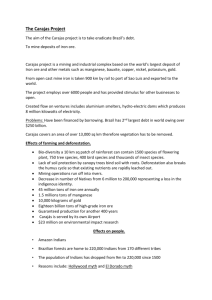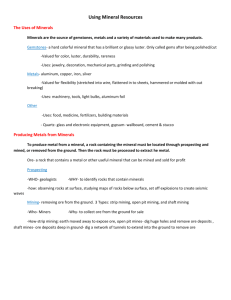Handout6-3aDone
advertisement
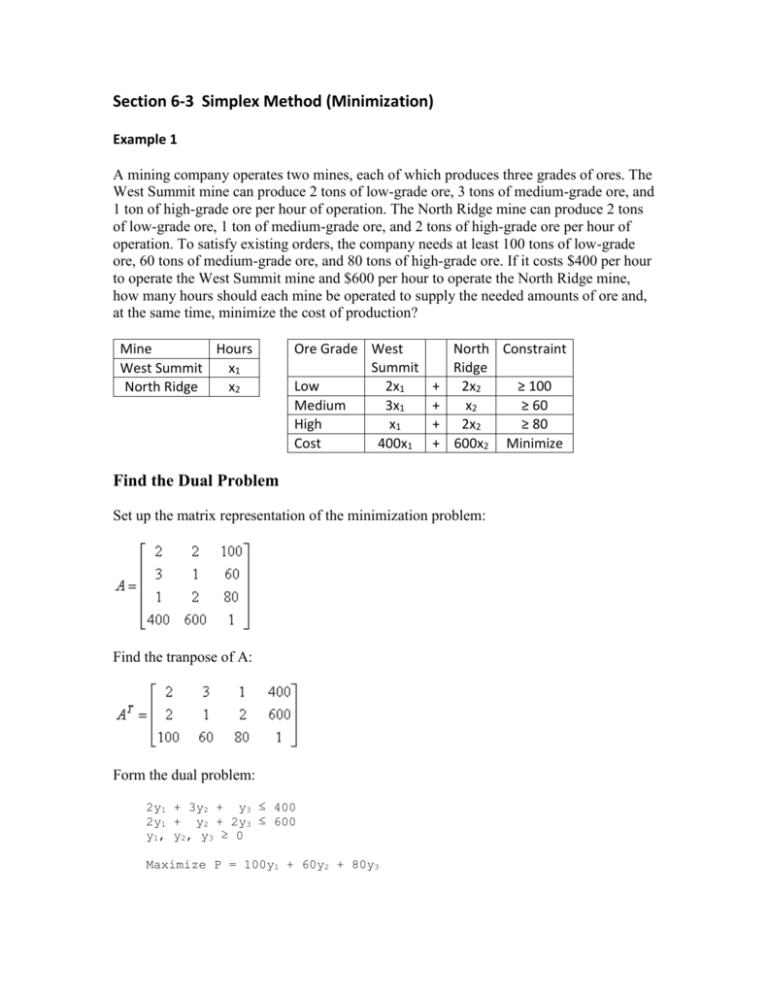
Section 6-3 Simplex Method (Minimization) Example 1 A mining company operates two mines, each of which produces three grades of ores. The West Summit mine can produce 2 tons of low-grade ore, 3 tons of medium-grade ore, and 1 ton of high-grade ore per hour of operation. The North Ridge mine can produce 2 tons of low-grade ore, 1 ton of medium-grade ore, and 2 tons of high-grade ore per hour of operation. To satisfy existing orders, the company needs at least 100 tons of low-grade ore, 60 tons of medium-grade ore, and 80 tons of high-grade ore. If it costs $400 per hour to operate the West Summit mine and $600 per hour to operate the North Ridge mine, how many hours should each mine be operated to supply the needed amounts of ore and, at the same time, minimize the cost of production? Mine Hours West Summit x1 North Ridge x2 Ore Grade West Summit Low 2x1 Medium 3x1 High x1 Cost 400x1 + + + + North Constraint Ridge 2x2 ≥ 100 x2 ≥ 60 2x2 ≥ 80 600x2 Minimize Find the Dual Problem Set up the matrix representation of the minimization problem: Find the tranpose of A: Form the dual problem: 2y1 + 3y2 + y3 ≤ 400 2y1 + y2 + 2y3 ≤ 600 y1, y2, y3 ≥ 0 Maximize P = 100y1 + 60y2 + 80y3 Introduce slack variables x1 and x2 into this dual problem (we'll see later why we call them x rather than s as we have been doing): 2y1 + 3y2 + y 3 + x1 = 400 2y1 + y2 + 2y3 + x2 = 600 -100y1 - 60y2 - 80y3 + P = 0 y1, y2, y3, x1, x2 ≥ 0 Solve the Dual Problem Solve the dual problem using the Simplex method. Find the entering variable: Basic Variables y1 y2 y3 x1 2 3 1 x2 2 1 2 P -100 -60 -80 x1 1 0 0 x2 0 1 0 P 0 400 0 600 1 0 x1 1 0 0 x2 0 1 0 P Quotient 0 400 400 /2 = 200 0 600 600 / 2 = 300 1 0 Find the exiting variable: Basic Variables y1 y2 y3 x1 2 3 1 x2 2 1 2 P -100 -60 -80 Perform a row operation to set the pivot element to 1: Basic Variables y1 y2 y3 x1 2 3 1 x2 2 1 2 P -100 -60 -80 *row(1/2, [A], 1) x1 1 0 0 x2 0 1 0 P Operation 0 400 (1/2)*R1 → R1 0 600 (-2)*R1 + R2 →R2 1 0 100*R1 + R3 → R3 You must set the pivot element to 1 first! *row+(-2, Ans, 1, 2) *row+(100, Ans, 1, 3) The variable y1 has entered the set of basic variables: Basic Variables y1 x2 P y1 1 0 0 y2 y3 x1 x2 P 3/2 1/2 1/2 0 0 200 -2 1 -1 1 0 200 90 -30 50 0 1 20,000 Select y3 as the entering variable and x2 as the exiting variable: Basic Variables y1 x2 P y1 1 0 0 y2 y3 x1 x2 P Quotient 3/2 1/2 1/2 0 0 200 200 / (1/2) = 400 -2 1 -1 1 0 200 200 / 1 = 200 90 -30 50 0 1 20,000 Since the pivot element is already one, all we have to do is perform row operations to set remaining values in the pivot column to zero: Basic Variables y1 x2 P y1 1 0 0 y2 y3 x1 x2 P Operation 3/2 1/2 1/2 0 0 200 (-1/2)* R2 + R1 → R1 -2 1 -1 1 0 200 90 -30 50 0 1 20,000 30*R2 + R3 → R3 *row+(-.5, Ans, 2, 1) *row+(30, Ans, 2, 3) The variable y3 has entered the set of basic variables: Basic Variables y1 y3 P y1 1 0 0 y2 5/2 -2 30 y3 0 1 0 x1 x2 P 1 -1/2 0 100 -1 1 0 200 20 30 1 26,000 Since there are no more negative values in the bottom row, we have the solution to the dual problem. Now, the amazing thing is that we can read the solution to the original minimization problem from the bottom row of this matrix: x1 = 20, x2 = 30, and the minimum cost is $26,000. The mining company's standing orders can be met by running the West Summit mine for 20 hours and running the North Ridge mine for 30 hours. This results in the minimum operating cost of $26,000. Graphical Interpretation Our solution did not rely on a graphical representation of the minimization problem. Nevertheless, it may be helpful to look at it and confirm our solution. In the graph below, the red line represents the low-grade ore constraint (2x1 + 2x2 ≥ 100). The green line represents the medium-grade ore constraint (3x1 + x2 ≥ 60). The blue line represents the high-grade ore constraint (x1 + 2x2 ≥ 80). The shaded region is the feasible region. The vertices of this region are listed in the table below along with the number of tons of each grade of ore that is mined and the corresponding costs of operation. x1 Hours x2 Hours 0 5 20 80 60 45 30 0 Low-Grade Medium-Grade High-Grade Cost (tons) (tons) (tons) 120 60 120 $36,000 100 60 95 $29,000 100 90 80 $26,000 160 240 80 $32,000 Notice that the optimal solution results in just enough low-grade and high-grade ore and a surplus of 30 tons of medium-grade ore.

